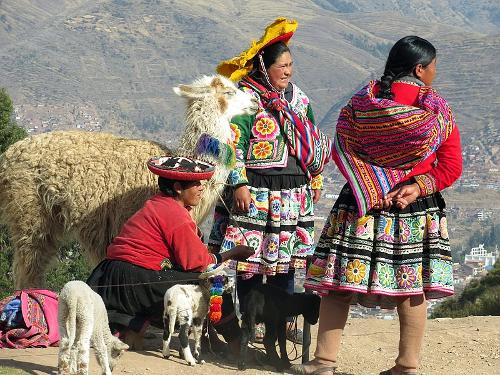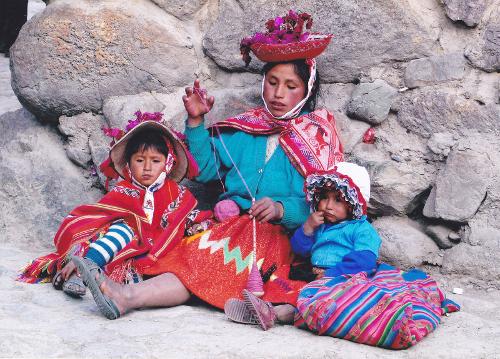PERU
Population

Population

Cities in PERU
| Lima |
Population
Composition and distribution
 Population PeruPhoto:SoleneC1 in the public domain
Population PeruPhoto:SoleneC1 in the public domain
It is estimated that in 2017 the Peruvian population consists of 45% pure-bred Indians, 37% mestizos and 15% Caucasians, mainly of Hispanic descent; 3% is of Asian, African or other origin. Most Indians live in the Andes and the Amazon region, while whites and mestizos often live on the coast, and especially in large cities such as Lima, Arequipa and Trujillo. Whites are still on the highest rung on the social ladder, followed by the mestizos and far below the Indians. After Bolivia, Peru is the South American country with the largest percentage of Indians.
The blacks are descended from slaves from Africa who were deployed on the haciendas; It is estimated that more than 800,000 arrived in Peru by 1810. Most blacks live in the Chincha area, south of Lima, because large sugar plantations used to be located there.
The Chinese and Japanese came to Peru between 1850 and 1920 as manpower for the construction of railways. Fujimori was the first president of Japanese descent. Between 1876 and 1920, many immigrants from Europe also settled in Peru: Italians, Spaniards, French, English and Germans.
 Quecha PeruPhoto: Peter van der Sluijs CC 3.0 no changes made
Quecha PeruPhoto: Peter van der Sluijs CC 3.0 no changes made
The Indians of the mountain regions, also called highland Indians, belong mainly to the Quechuas, in the region around Lake Titicaca mainly live Aymarás. The Quechuas can be divided into different groups, which differ from each other in costume, customs and the region where they live.
A unique group of Aymará Indians are the Uros, who live in the bay of Puno on floating islands made of totora reeds. In recent decades, their culture has been seriously affected by increasing tourism and mixed marriages with Aymarás.
Several small tribes live in the Amazon, each with its own language and customs and customs. These rainforest Indians are the indigenous people of the Amazon lowlands. The lifestyles of some tribes have changed radically through contact with Western people. Other tribes avoid almost any contact with Western humans.
Yahua’s and Shipibo’s live in the vicinity of Iquitos; the central part of the rainforest is home to the Asháninkas and Machiguengas; Yora's live in the vicinity of Manu National Park.
Two tribes that are only known to exist are called Mashco Piro and Kogapacori and live in the southeastern jungle. The Lamas Indians live in the vicinity of Tarapoto.
In the past all these tribes led a semi-nomadic existence, now they often live in a fixed place through the use of modern means of transport. The main livelihoods are still agriculture and hunting. Some tribes earn a little extra with crafts for tourists. On the other hand, tourism in particular poses a serious threat to the real nature peoples. Their hunting grounds are being disrupted and their social life and traditions are under severe strain.
Today there are approximately 200,000 Amazon Indians living in Peru, divided into 53 ethnic groups, who speak languages from 12 different linguistic families. Some groups, such as the Toyeri, consist of only a few dozen people. Others, such as the Machiguenga, the Yahua and the Campa, have a population of several (ten) thousands.
Demographic data
The annual population growth amounted to 2.1% per year in the period 1985-1995 and declined to around 1% in the 21st century (2017: 0.95%); the population has increased from 10.3 million in 1961 to 23.8 million in 1995 and in 2017 it rose to more than 31 million. The population density is approximately 24 inhabitants per km2.
Birth and death rates were 17.8 and 6.1 per thousand in 2017 respectively; the infant mortality rate was 18 per 1,000 live births. The average life expectancy at birth is 76.1 years for women and 71.9 years for men. Approximately 78% of the population lives in cities (46% in 1960).
The largest population concentration is formed by the capital Lima, namely 10.4 million inhabitants (1900: approx. 100,000 inhabitants).
The age distribution of the Peruvian population is as follows:
- 0-14 years: 26.3%
- 15-64 years: 65.3%
- 65+: 7.4%
Sources
Le Grand, J.W. / Peru : mensen, politiek, economie, cultuur
Koninklijk Instituut voor de Tropen : Novib
Luft, A. / Peru
Elmar,
Lyle, G. / Peru
Chelsea House Publishers,
Peru
Cambium,
Peru, Bolivia
Lannoo
Rensink, E. / Peru
Gottmer,
Te gast in Peru
Informatie Verre Reizen
CIA - World Factbook
BBC - Country Profiles
Copyright: Team The World of Info